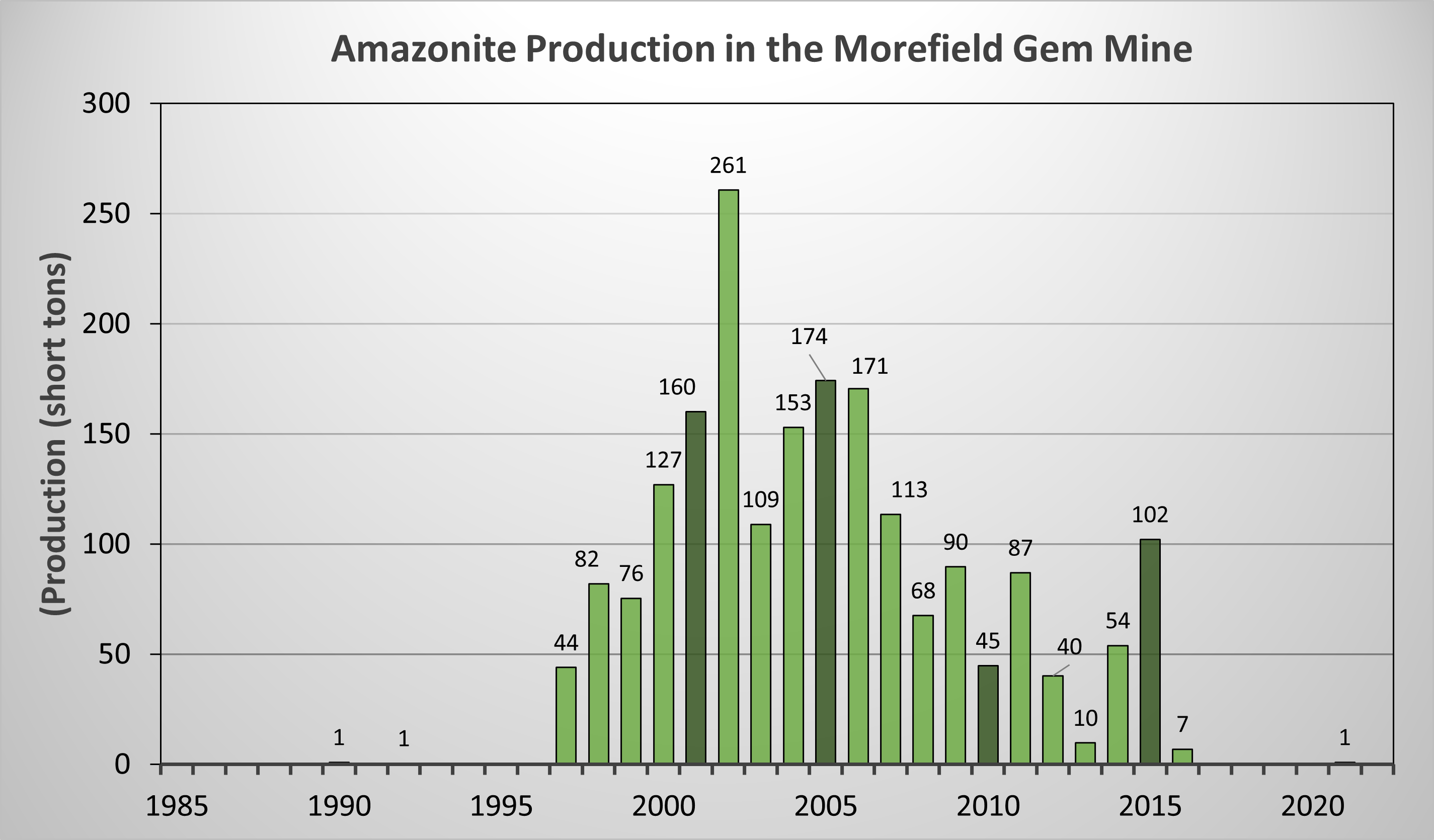Amazonite is an attractive gemstone known for its distinctive blue and green color. It is a variety of potassium feldspar called microcline. Its chemical formula is KAlSi3O8, indicating it is composed of the elements potassium, aluminum, silicon, and oxygen. Amazonite is commonly found in granitic pegmatites, which are coarse-grained igneous rocks. These rocks form during the final stages of magma cooling and crystallization deep within the Earth's crust. As the molten rock cools, the minerals within it begin to crystallize, and under favorable conditions, large-sized crystals can develop.

Morefield Gem Mine, Amelia County
The Morefield Gem Mine, located in Amelia County, Virginia, has a rich history spanning several decades. The mine is considered to have the best amazonite in the United States and has been a popular destination for gemstone enthusiasts and rockhounds seeking unique treasures from the Earth. Learn more about the Morefield Gem Mine here »

Morefield Gem Mine, 45 foot level
Pegmatites in the Morefield Gem Mine in Amelia County, Virginia contain several common minerals including bluish-green amazonite, black platy biotite, milky-white platy cleavlandite (albite plagioclase), and the grey, glassy mineral quartz. This photo below was taken at 45 ft below the ground surface. The mineral crystals are up to 10 cm long.
The specific age of the amazonite-bearing pegmatites in Virginia varies depending on the location. The Morefield Gem Mine in Amelia County, for example, is estimated to have pegmatites that formed around 330 million years ago during the late Paleozoic. Pegmatites are economically important as sources of various minerals. Some pegmatites are mined for their gemstone deposits (e.g., amazonite, beryl, tourmaline), while others are exploited for industrial minerals (e.g., feldspar, mica) and rare elements (e.g., lithium, tantalum, cesium).
As a gemstone, amazonite holds significance in various cultures and has been used for centuries in jewelry and as an ornamental stone. It is valued not only for its vibrant color but also for its supposed metaphysical properties, which are believed to promote harmony, balance, and emotional healing. The source of amazonite's color is a small quantity of lead and water in the feldspar crystal structure.
Year of first production in Virginia: 1929
Year of last production in Virginia: 2023
Total cumulative production in Virginia: 2000 short thousand tons
Current annual production in Virginia: none

Selected References:
Giannini, William F., and Sweet, Palmer C., 1991, Tantalian and niobian resources in Virginia: Virginia Division of Mineral Resources Publication 115, 28 pages.
Kearns, Lance E., 1996, Bermanite from the Morefield Pegmatite, Amelia County, Virginia: Virginia Minerals vol. 42, no. 2, p. 19.
Kearns, Lance E., 1992, Pyromorphite from the Morefield Mine, Amelia County, Virginia: Virginia Minerals vol. 38, no. 2, p. 14.
Kearns, Lance E., 1992, Prosopite from the Morefield Mine, Amelia County, Virginia: Virginia Minerals vol. 38, no. 2, p. 14-15.
Kearns, Lance E., and Martin, Betsy S., 2000, The Morefield Pegmatite, Amelia, Virginia. Mineral Update: Virginia Minerals vol. 46, no. 2, p. 9-13.
Penick, Jr., D. Allen, and Giannini, William F., 1992, Large spessartine garnet discovery: Virginia Minerals vol. 38, no. 2, p. 15-16.
Penick, Jr., D. Allen, and Sweet, Palmer C., 1992, Mineral Collecting Sites in Virginia: Virginia Minerals vol. 38, no. 2, p. 9-12.
Smerekanicz, John R., Dudas, Francis O., and Baltzely, William D., 1991, Strengite, a new mineral from the Morefield pegmatite mine, Amelia County, Virginia: Virginia Minerals vol. 37, no. 4, p. 31-32.
Sweet, Palmer C., 1999, Vein quartz in Virginia: Virginia Minerals vol. 45, no. 3, p. 23.
Virginia Department of Energy, 2023, Annual production reports submitted by mine operators, Division of Mineral Mining.
